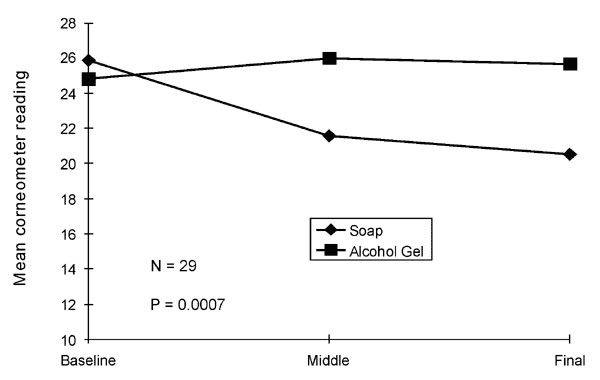Volume 7, Number 2—April 2001
THEME ISSUE
4th Decennial International Conference on Nosocomial and Healthcare-Associated Infections
Prevention is Primary
Antiseptic Technology: Access, Affordability, and Acceptance
Figure 2

Figure 2. Electrical capacitance of dorsal hand skin surface (5).
References
- Larson EL; APIC Guidelines Committee. APIC guideline for handwashing and hand antisepsis in health care settings. Am J Infect Control. 1995;23:251–69. DOIPubMedGoogle Scholar
- Rotter M. Hand washing and hand disinfection. In: Mayhall CG, editor. Hospital epidemiology and infection control. 2nd ed. Philadelphia: Lippincott Williams & Wilkins; 1999. p. 1339-55.
- Ojajarvi J. The importance of soap selection for routine hand hygiene in hospital. J Hyg (Camb). 1981;86:275–83. DOIPubMedGoogle Scholar
- Larson E, Killien M. Factors influencing handwashing behavior of patient care personnel. Am J Infect Control. 1982;10:93–9. DOIPubMedGoogle Scholar
- Boyce JM, Kelliher S, Vallande N. Skin irritation and dryness associated with two hand-hygiene regimens: soap and water hand washing versus hand antisepsis with an alcoholic hand gel. Infect Control Hosp Epidemiol. 2000;21:442–8. DOIPubMedGoogle Scholar
- Voss A, Widmer AF. No time for handwashing? Handwashing versus alcoholic rub: can we afford 100% compliance? Infect Control Hosp Epidemiol. 1997;18:205–8. DOIPubMedGoogle Scholar
- Preston GA, Larson EL, Stamm WE. The effect of private isolation rooms on patient care practices, colonization and infection in an intensive care unit. Am J Med. 1981;70:641–5. DOIPubMedGoogle Scholar
- Kaplan LM, McGuckin M. Increasing handwashing compliance with more accessible sinks. Infect Control. 1986;7:408–10.PubMedGoogle Scholar
- Pittet D, Mourouga P, Perneger TV. members of the Infection Control Program. Compliance with handwashing in a teaching hospital. Ann Intern Med. 1999;130:126–30.PubMedGoogle Scholar
- Freeman J. Prevention of nosocomial infections by location of sinks for hand washing adjacent to the bedside Abstract 60]. Program and Abstracts of the 33rd Interscience Conference on Antimicrobials and Chemotherapy. Washington, DC: American Society for Microbiology; 1993.
- Larson E, McGeer A, Quraishi A, Krenzischek D, Parsons BJ, Holdford J, Effect of an automated sink on handwashing practices and attitudes in high-risk units. Infect Control Hosp Epidemiol. 1991;12:422–8. DOIPubMedGoogle Scholar
- Wurtz R, Moye G, Jovanovic B. Handwashing machines, handwashing compliance, and potential for cross-contamination. Am J Infect Control. 1994;22:228–30. DOIPubMedGoogle Scholar
- Bischoff WE, Reynolds TM, Sessler CN, Edmond MB, Wenzel RP. Handwashing compliance by health care workers. Arch Intern Med. 2000;160:1017–21. DOIPubMedGoogle Scholar
- Zimakoff J, Kjelsberg AB, Larsen SO, Holstein B. A multicenter questionnaire investigation of attitudes toward hand hygiene, assessed by the staff in fifteen hospitals in Denmark and Norway. Am J Infect Control. 1992;20:58–64. DOIPubMedGoogle Scholar
- Scott D, Barnes A, Lister M, Arkell P. An evaluation of the user acceptability of chlorhexidine handwash formulations. J Hosp Infect. 1991;18:51–5. DOIPubMedGoogle Scholar
- Larson E, Leyden JJ, McGinley KJ, Grove GL, Talbot GH. Physiologic and microbiologic changes in skin related to frequent handwashing. Infect Control. 1986;7:59–63.PubMedGoogle Scholar
- Rotter ML, Koller W, Neumann R. The influence of cosmetic additives on the acceptability of alcohol-based hand disinfectants. J Hosp Infect 1991;18 Suppl B:57-63.
- Pittet D, Hugonnet S, Harbarth S, Mourouga P, Sauvan V, Touveneau S. Effectiveness of a hospital-wide programme to improve compliance with hand hygiene. Lancet. 2000;356:1307–12. DOIPubMedGoogle Scholar
Page created: May 10, 2011
Page updated: May 10, 2011
Page reviewed: May 10, 2011
The conclusions, findings, and opinions expressed by authors contributing to this journal do not necessarily reflect the official position of the U.S. Department of Health and Human Services, the Public Health Service, the Centers for Disease Control and Prevention, or the authors' affiliated institutions. Use of trade names is for identification only and does not imply endorsement by any of the groups named above.